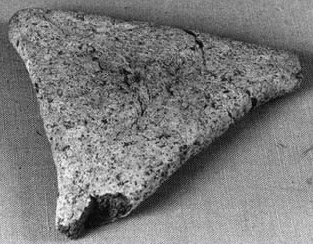Ancient Egyptians, depending on their wealth and status, could have a varied diet, but central to their nourishment was bread and beer. From very early on, both were consumed at every meal, by everyone, and no meal was considered complete without them. Bread, nutritionally, provided protein, starch and trace nutrients, and it also played much the same role as beer in the Egyptian economy as well as in cult rituals. However, some flour caused severe abrasion of the teeth particularly among those who depended upon bread as their main source of nourishment. But this affected all classes and even Amenhotep III suffered badly from such problems.
Bread was made from a variety of ingredients, though often only a specific species of wheat was thought best (Triticum aestivum), though almost any cereal was suitable. Depending on the type of flour, the structure and texture of a loaf could be very different, and just as today, all breads were not light, risen or spongy.
Thankfully, the climate of Egypt, which is very arid in many locations, is responsible for preserving a rich record of organic materials, including bread loaves. Hundreds of specimens have survived, mostly from funerary offerings that have found their way into the museums of the world. These even include fragments from Predynastic graves of the Badarian culture. Talk about stale! These loaves are over five thousand years old.
Thankfully, the climate of Egypt, which is very arid in many locations, is responsible for preserving a rich record of organic materials, including bread loaves. Hundreds of specimens have survived, mostly from funerary offerings that have found their way into the museums of the world. These even include fragments from Predynastic graves of the Badarian culture. Talk about stale! These loaves are over five thousand years old.
These ancient loaves, though a direct source of evidence about ancient Egyptian bread and baking, have actually not been studied much by modern scholars. Hence, though many breads and cakes are known from historical documents, their distinguishing features are in fact unknown. Some scholars have suggested that pesen-bread was a flat round loaf, not unlike that found in Egypt today. However, preserved loaves have shown that breads of the same shape were not always made from the same ingredient or the same recipe and, therefore, may not have been known by the same name. For example, extant hand-formed conical loaves were frequently made from emmer wheat (Triticum dicoccum), though one known specimen was made mostly from figs (Ficus carica). At the same time, various shapes and textures of bread could also be made from the same batch of dough.
We mostly know the process of baking from the evidence of artistic scenes in which it is depicted. For example, one of the best examples comes from a relief in a 5th Dynasty tomb at Saqqara belonging to Ti. However, there are also Old Kingdom statuettes that portray baking activities. Middle Kingdom models, notably from the tomb of Meketra, also provide some details, as well as give us a idea of a busy, robust bakery. Also, several tombs at Beni Hasan contain bread-making scenes, and at least one other is found in the New Kingdom wall paintings of Nebamun's tomb on the West Bank of Thebes (modern Luxor).
We mostly know the process of baking from the evidence of artistic scenes in which it is depicted. For example, one of the best examples comes from a relief in a 5th Dynasty tomb at Saqqara belonging to Ti. However, there are also Old Kingdom statuettes that portray baking activities. Middle Kingdom models, notably from the tomb of Meketra, also provide some details, as well as give us a idea of a busy, robust bakery. Also, several tombs at Beni Hasan contain bread-making scenes, and at least one other is found in the New Kingdom wall paintings of Nebamun's tomb on the West Bank of Thebes (modern Luxor).
The preparations for making bread in Ancient Egypt were somewhat more difficult that in our modern times, principally because of the distinctive nature of their staple wheat, emmer, which differs in some properties from most modern wheat used to make bread. Emmer was used into the Ptolamic Period. Today, typical bread wheat (Triticum aestivum) has ears that easily separate into chaff and grain when threshed. The traditional process for processing it uses winnowing and sieving to remove the chaff from the grain.
However, emmer requires more extensive processing, which at least in families was usually performed by women. Usually, only enough grain was ground at one time to fill the needs of a day's meals.
However, emmer requires more extensive processing, which at least in families was usually performed by women. Usually, only enough grain was ground at one time to fill the needs of a day's meals.
After threshing, it breaks into packets called spikelets, each of which is a thick envelope of chaff that tightly surround two kernels. Prior to winnowing and sieving to clean the chaff from the kernels, a process is needed to break the chaff apart without damaging the grain.
From various research and experimental evidence, we do have some idea of the procedures employed to processes the spikelets by the ancient Egyptians. We believe that whole spikelets were moistened with a small amount of water and than pounded with wooden pestles in limestone mortars. Since the water made the spikelets pliable, the chaff could be shredded without crushing the grain kernels inside. This was not a time consuming process, although the ancient Egyptian mortars were usually small and several batches of spikelets had to be processed before enough freed kernels were produced to make bread for even a family. Even after this added process, the released grain kernels and broken chaff then had to be tried, probably under the sun. Afterwards, it went through a series of winnowing steps, and sieving, The sieves made from rushes and the like were not very efficient and allowed grains of sand and little flakes of stone to remain in the flour, especially when soft mill stones were used. In fact, the last step in the process was the removal of final fragments of chaff which were picked out by hand.
Next, the the whole grain was milled into flour, usually using a flat grinding stone known as a saddle quern. From Neolithic times through the Old Kingdom, these grinding stones were placed on the floor, which made the process difficult. However, tombs scenes of the Middle Kingdom show the querns raised onto platforms, called quern emplacements. Some of these have been excavated at a few New Kingdom sites. They made life much easier, and probably made the work quicker as well. Modern experimentation with these devices has shown that no grit was required to aid the milling process, as has sometimes been suggested by scholars, and the the texture of the flour could be precisely controlled by the miller.
Baking also evolved over ancient Egypt's long history. Excavation of a bakery dating to the Old Kingdom at Giza evidences that heavy pottery bread molds were set in rows on a bed of embers to bake the dough placed within them. By the Middle Kingdom, square hearths were used, and the pottery moulds were altered into tall, narrow, almost cylindrical cones. Then, by the New Kingdom, a new oven was introduced with a large, open-clay cylinder encased in thick mud bricks and mortar. The flat disks of dough, perhaps leavened, were slapped onto the pre heated inner oven wall. When baked, they peeled off and were caught before they could fall into the embers below.
Next, the the whole grain was milled into flour, usually using a flat grinding stone known as a saddle quern. From Neolithic times through the Old Kingdom, these grinding stones were placed on the floor, which made the process difficult. However, tombs scenes of the Middle Kingdom show the querns raised onto platforms, called quern emplacements. Some of these have been excavated at a few New Kingdom sites. They made life much easier, and probably made the work quicker as well. Modern experimentation with these devices has shown that no grit was required to aid the milling process, as has sometimes been suggested by scholars, and the the texture of the flour could be precisely controlled by the miller.
Baking also evolved over ancient Egypt's long history. Excavation of a bakery dating to the Old Kingdom at Giza evidences that heavy pottery bread molds were set in rows on a bed of embers to bake the dough placed within them. By the Middle Kingdom, square hearths were used, and the pottery moulds were altered into tall, narrow, almost cylindrical cones. Then, by the New Kingdom, a new oven was introduced with a large, open-clay cylinder encased in thick mud bricks and mortar. The flat disks of dough, perhaps leavened, were slapped onto the pre heated inner oven wall. When baked, they peeled off and were caught before they could fall into the embers below.
Bread loaves are especially numerous in tombs of the New Kingdom, and are not limited as to size, shape or decorations. In fact, some loaves were formed into recognizable shapes, such as fish and human figures. Others were not as fancy, taking simple shapes such as disks and fans. The dough textures of these loaves range from very fine to mealy, mostly only indicating the people, as today, probably had preferences in the type of bread they liked to eat. Whole or coarsely cracked cooked grains were often added, creating a texture not unlike modern multigrain breads. Emmer flower was almost always used for these loaves. Barley (Hordeum vulgare) was very rarely used in these bread loaves, and the amount that does show up is in such small amounts that it may have accidentally gotten into the mix. Somtimes, the sour dough left over from the previous day might be added, or some barm from the last time beer was brewed. There were flavorings, such as coriander seeds (Coriandrum sativum), honey, butter, eggs, oil an herbs, as well as fruits such as dates (Phoenix dactylifera) which were occasionally added. Yeast might also be added to some recipes, but leavening was not always used.
Seemingly, brad flavored with more exotic ingredients were probably only infrequently available to the poorer classes of Egyptians, though more research is needed to determine what breads were available to the various social classes. Unfortunately, funerary loaves comprise most of our evidence of early breads, which might not be representative of the day-to-day variety. However, the remains of cereal-processing equipment and baking installations at settlements sites has provided some evidence for the preparation of ancient Egyptian bread, and these sites may yet yield up more typical loaves.
Seemingly, brad flavored with more exotic ingredients were probably only infrequently available to the poorer classes of Egyptians, though more research is needed to determine what breads were available to the various social classes. Unfortunately, funerary loaves comprise most of our evidence of early breads, which might not be representative of the day-to-day variety. However, the remains of cereal-processing equipment and baking installations at settlements sites has provided some evidence for the preparation of ancient Egyptian bread, and these sites may yet yield up more typical loaves.




















